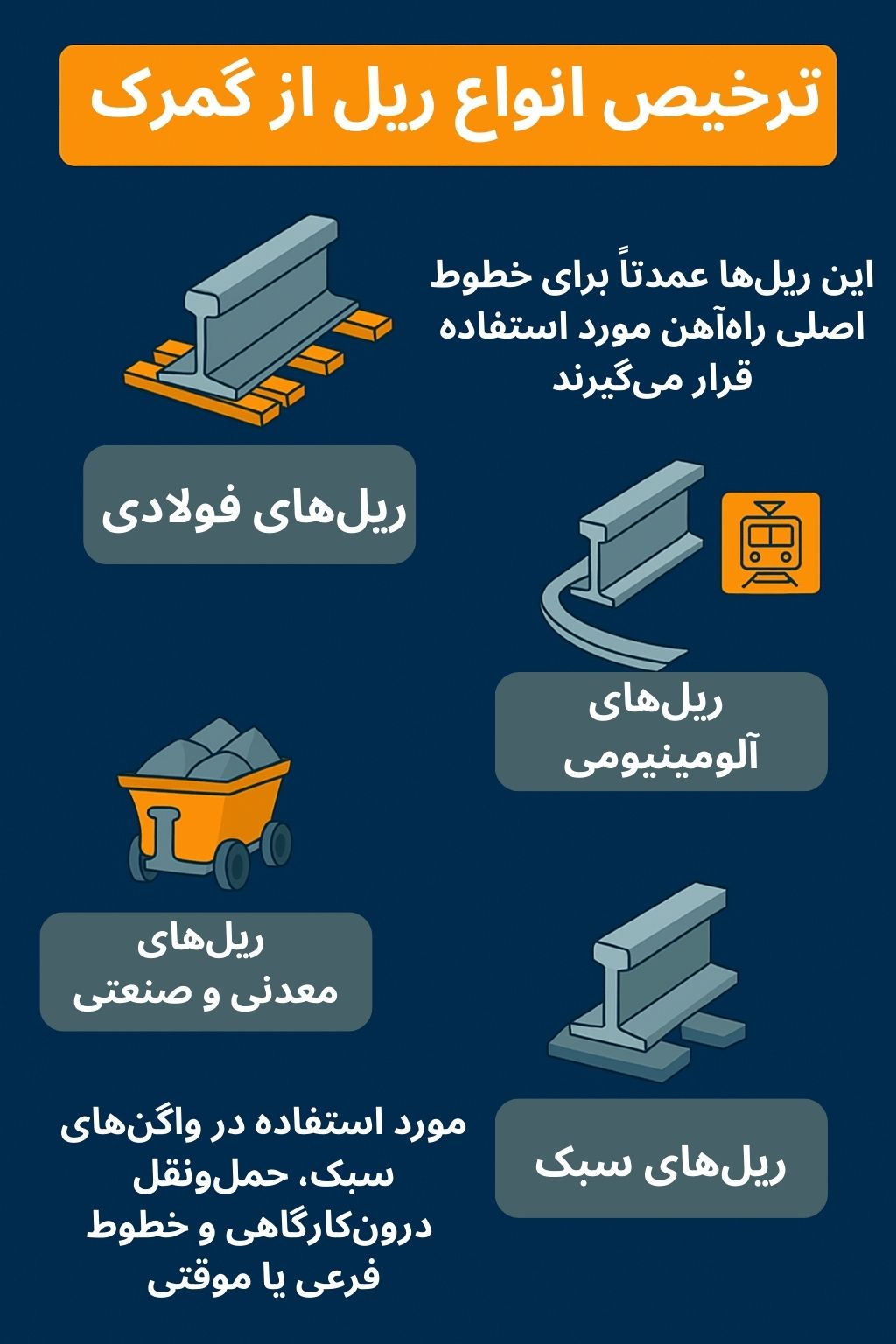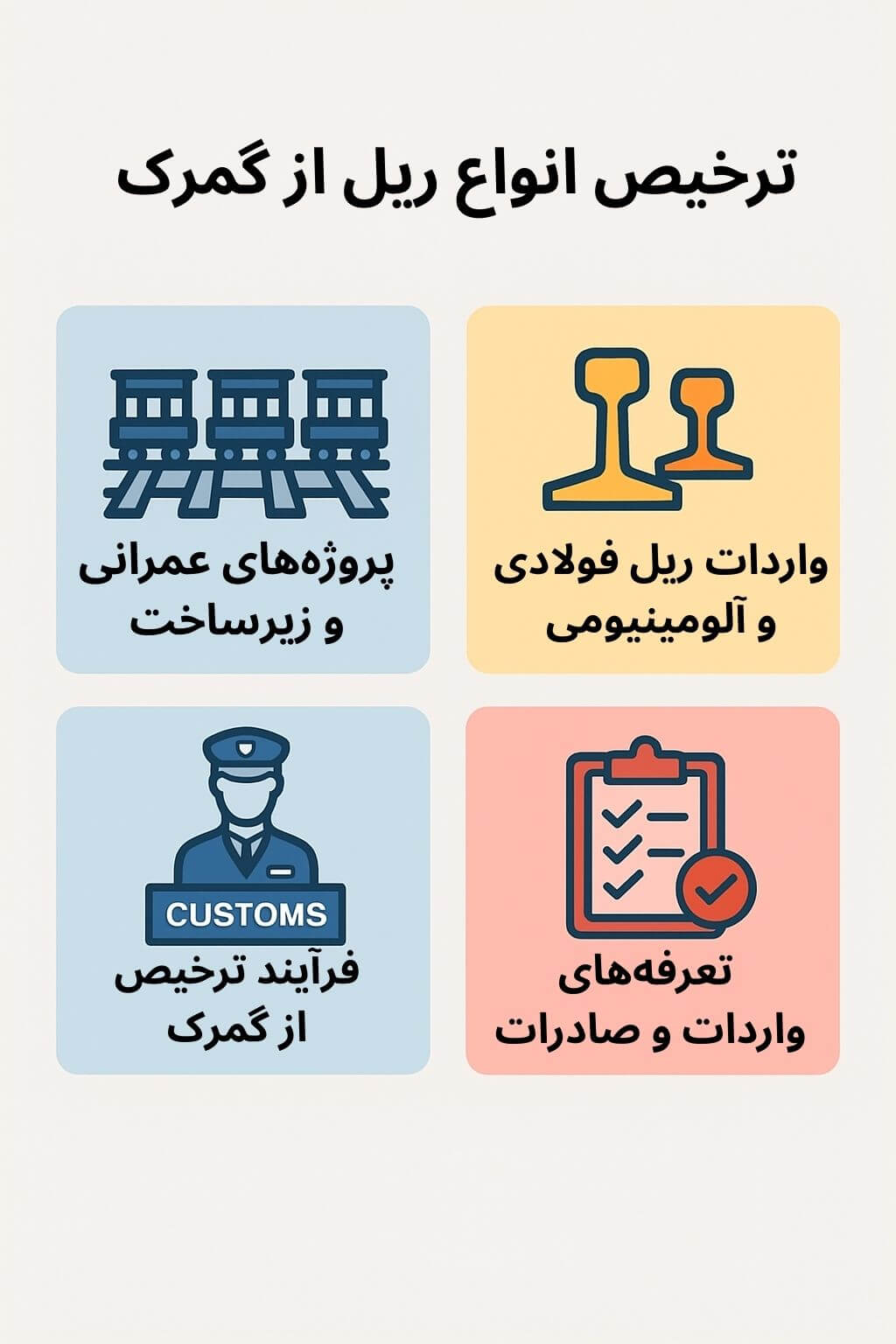Customs Clearance of Various Rails in Iran (HS Code + Documents & Permits)
To estimate the time and cost of clearing various rails please contact the Saba Tarkhis experts.
Instant Free Consultation
1) HS Codes and Uses of Rail Types
Customs Tariff (HS Code): 73021000
Steel rails are the most widely used in the railway industry and infrastructure projects. Thanks to their very high durability and resistance to pressure and abrasion, they are used on most rail transport lines. These rails are also used in heavy industrial projects.
Customs Tariff (HS Code): 76011000
Aluminum rails, which weigh less than steel ones, are used in some light transport systems such as tramways or specific industrial segments. Due to their light weight and adequate strength, they are also popular in certain industrial applications.
Customs Tariff (HS Code): 73021000
These rails are designed specifically for industrial environments and mines. They are used to move heavy materials or industrial equipment in harsh, high-pressure environments and, due to the need for higher resistance, are made of high-quality steel.
Customs Tariff (HS Code): 73021010
Light rails are typically used in smaller projects and urban transport systems. Because of simpler installation and lower weight, they are used in short-term and temporary projects and are suitable for lighter applications.
Customs Tariff (HS Code): 86080010
These rails are designed for urban transport systems such as tramways. Tram-specific rails must meet special standards to be suitable for urban environments.
Customs Tariff (HS Code): 73029000
These rails are designed specifically for crane movement and heavy equipment in industrial environments. Crane rails must have high strength to bear heavy loads and ensure reliable performance.
Customs Tariff (HS Code): 73021000
Rails designed for transporting heavy cargo are used in large civil projects and industrial rail lines. Because they carry very heavy loads and are used in high-traffic environments, they are made of highly durable steel.
Customs Tariff (HS Code): 73029090
These rails have been previously used and may be imported for reuse or recycling. Importing recycled rails is usually for projects with lower budgets; however, their quality must be carefully assessed.
| Goods | Short Description | HS Code |
|---|---|---|
| Steel rail | Railway/industrial rail with high durability | 73021000 |
| Aluminum rail | Lighter for specific use/tramway | 76011000 |
| Light rail | Urban/small projects | 73021010 |
| Tram rail | Urban transport/tramway | 86080010 |
| Crane/industrial rail | Crane movement/heavy equipment | 73029000 |
| Used/recycled rail | For reuse/recycling | 73029090 |
Exact classification depends on material, unit weight (kg/m), profile, production standard, new/used status, and end use.
2) Specific Conditions for Rail Import and Export
1. Major rail-exporting countries
2. Rail imports to Iran
3. Rail exports from Iran
Import and export volumes of rail to Iran
Global rail trade turnover
Top rail-importing countries worldwide
3) The Best & Simplest Way to Clear Rails from Customs
1. Prepare complete and accurate documents
Commercial invoice: includes full details on price, quantity, and product specs.
Packing list: includes packaging details and technical specs of the rails.
Certificate of origin: issued by the chamber of commerce in the country of origin, indicating the producing country.
Import permits (if required): in some cases, specific permits may be needed depending on destination-country laws.
2. Use specialized customs brokerage services
Working with brokerage firms experienced in clearing heavy and strategic goods such as rail can simplify the process. Thanks to sufficient knowledge of customs law, documentation, and administrative steps, these firms can reduce clearance time and costs.
3. Accurate customs valuation & proper transport
As heavy and valuable cargo, rails must be carefully valued by customs. Also, selecting the proper transport mode (e.g., rail or sea) can minimize risks and prevent cargo damage. Insuring rail shipments is recommended due to their high value.

4) Required Documents for Clearing Various Rails
-
1. Commercial invoice
The invoice includes key information such as price, quantity, and rail type, issued by the seller or exporter. It is the basic document used to calculate customs value and duties. -
2. Packing list
Provides precise details on the number, weight (net and gross), and dimensions of packages. It helps customs check packages and accurately assess the shipment. -
3. Certificate of origin
Indicates the producing country and is issued by the chamber of commerce in the origin country. It plays a major role in determining customs tariffs and any possible preferences. -
4. Bill of lading
Issued by the carrier, the B/L describes the rail shipment. It includes information about the transport mode, origin, and destination and shows the rails are en route to the final destination. -
5. Customs valuation sheet
Based on this document, customs assesses the value and determines duties and taxes—usually drawing on the invoice and packing list. -
6. Import permit
In certain cases, importing rails requires permits from relevant authorities—e.g., for meeting technical standards or due to the strategic nature of the goods. -
7. Pre-shipment inspection certificate
Required in some cases/countries, confirming the shipment was technically and qualitatively inspected and approved before export. -
8. Certificate of conformity
Some countries require rails to comply with specific standards. This certificate confirms compliance with national or international standards. -
9. Cargo insurance certificate
Shows the rail shipment is insured and losses will be compensated in unforeseen events. Given the high value, insurance is highly recommended. -
10. Customs declaration form
Submitted by the importer or their agent to customs, detailing the goods, value, and applicable tariffs. Essential to complete the clearance process.
Need precise HS classification, permits, and document preparation? Our team manages everything end-to-end.
Request a Proforma QuoteFrequently Asked Questions
What are common HS Codes for rails?
Depending on material and use: 73021000 (steel/industrial rail), 73021010 (light rail), 73029000 (crane rail), 73029090 (used), 76011000 (aluminum rail), and for tramways 86080010. Final classification depends on technical specs and production standard.
What documents are required to clear rails?
As per your list: invoice, packing list, certificate of origin, bill of lading, customs valuation sheet, import permit (as applicable), pre-shipment inspection, certificate of conformity, insurance, and customs declaration.
What’s the fastest way to clear rails?
Accurate, complete documentation, using a specialized broker, choosing the right transport (rail/sea), and full cargo insurance.
Special Customs Clearance Services by Saba Brokerage
With years of experience in clearing industrial and infrastructure goods, Saba Brokerage offers specialized services for rail clearance. Leveraging seasoned experts and full command of Iranian and international customs regulations, the company helps rail importers and exporters complete clearance optimally, at minimal cost, and in the fastest possible time.
Key services include:
Specialized consulting: guidance on documentation, selecting the correct HS code, and complying with all customs regulations.
Continuous, accurate follow-up: monitoring and pursuing all clearance stages to reduce time and extra costs.
Customized services: tailored solutions based on specific client needs, focusing on risk reduction and process efficiency.
Partnering with this company ensures your rails are cleared quickly and without issues.
Contact our experts for more information.
.png)
